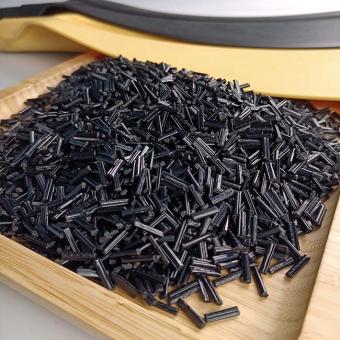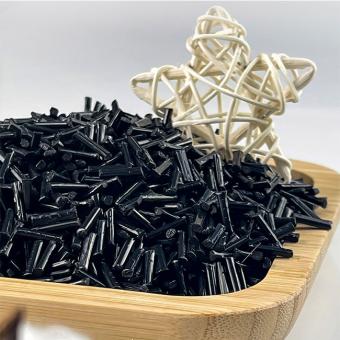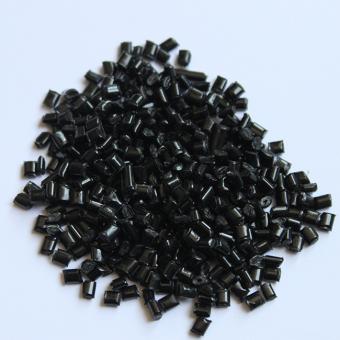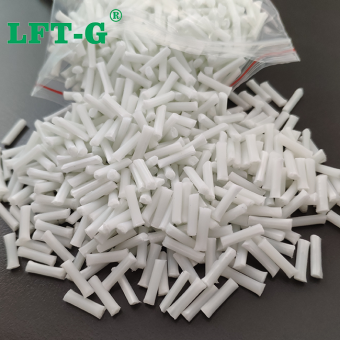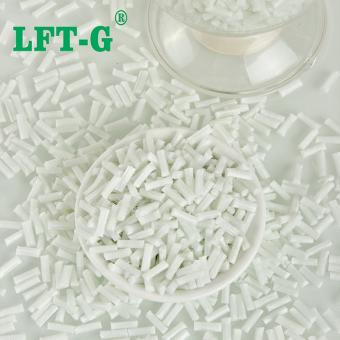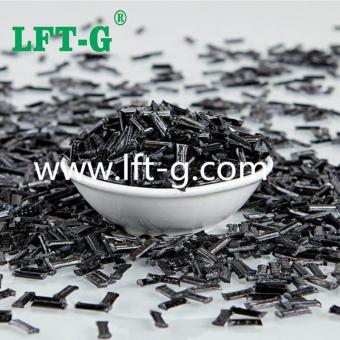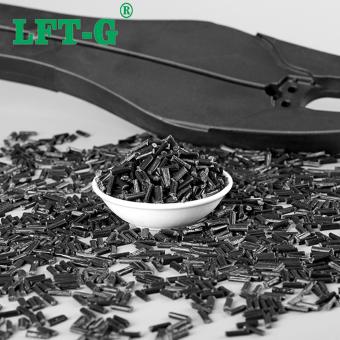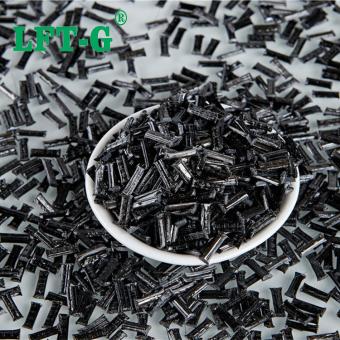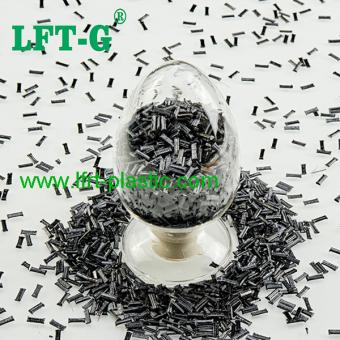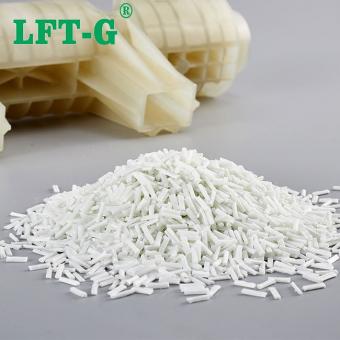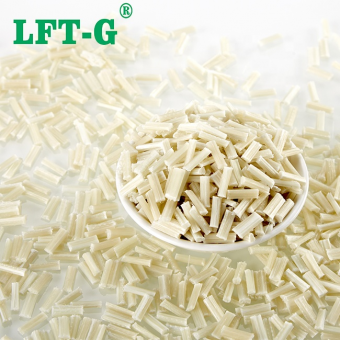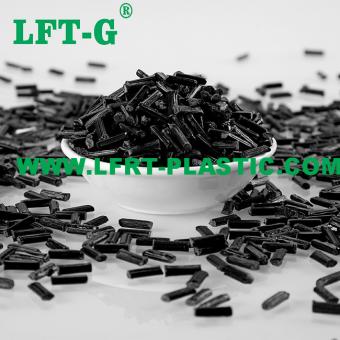-
LFT-D PP reinforced plastic filling long carbon fiber polypropylene higher performance 12mm natural colorPP material PP is a polymer made of propylene as monomer by coordination polymerization, and is one of the five major general-purpose plastics PE, PP, PVC, PS and ABS. 1. colorless, tasteless, five toxic, unadded PP material compounded with FDA and other food-grade material requirements; 2. due to the crystalline nature of PP, the original color milky white translucent, better transparency than PE; 3. low specific gravity of 0.9, almost one of the lightest plastics than water; 4. good toughness, especially repeated resistance to bending ability, commonly known as 100 fold rubber; 5. better heat resistance than PE, which can reach up to 120°C; 6. good resistance to hydrolysis and can be sterilized by high temperature steam 7. good chemical resistance, especially acid resistance, can be due to the storage of concentrated sulfuric acid containers; 8. outdoor use is susceptible to light, ultraviolet light and other aging. Modified PP material PP material by filling carbon fiber can increase the rigidity and modulus of PP material, reduce the material deformation caused by shrinkage, but at the same time the material toughness decreases. By adding anti-UV agent, anti-aging agent can improve the outdoor use performance of PP, and adding flame retardant material can improve the flame retardant performance of PP. TDS for reference only SGF VS LGF Long carbon fiber specification Application Product processing We will offer you 1. LFT&LFRT material technical parameters and leading edge design 2. Mold front design and recommendations 3. Provide technical support such as injection molding and extrusion molding
- carbon fiber reinforced plastics granules
- long carbon fiber reinforced pp
- long fiber compounds pp
- long fiber composite PP granules
- long carbon fiber polypropylene
Tags :
-
LFT-G PA6 LCF nylon6 filling long carbon fiber reinforced material high quality for manufacturing helmesPolyamide6 Nylon 6 (PA6) as a general engineering plastics, with light weight, wear resistance, corrosion resistance, good toughness and other characteristics, and as a common thermoplastic resin, its heating can be softened, cooling can be hardened, and can be repeatedly heated softening, cooling hardening, repeated processing characteristics. Long carbon fiber With high strength, high modulus, large specific surface area and aspect ratio, and high electrical conductivity, carbon fiber fabrics have superior mechanical properties compared to glass fiber and can provide maximum strength in the fiber direction. Carbon fiber reinforced composites are stronger than polymer matrix materials, while maintaining the advantage of light weight, and are gradually replacing traditional metal materials in the fields of electronic products, electric vehicles, medical devices, industrial equipment and sports and leisure products. LCF VS SCF Advantage of LCF (1) High strength and high toughness (2) Small coefficient of thermal expansion (3) Low hardness and light weight (4) Corrosion resistance and aging resistance (5) Temperature resistance TDS for reference Application Suitable for manufacturing helmets, car bumps and robotic arm etc. Certifications Injection molding Factory & Warehouse Teams & Customers About us Xiamen LFT composite plastic Co., Ltd is a brand-name company that focuses on LFT&LFRT. Long Glass Fiber Series (LGF) & Long Carbon Fiber Series (LCF). The company's thermoplastic LFT can be used for LFT-G injection molding and extrusion, and can also be used for LFT-D molding. It can be produced according to customer requirements: 5~25mm in length. The company's continuous infiltration reinforced thermoplastics have passed ISO9001&16949 system certification, and the products have obtained lots of national trademarks and patents.
- long fibre reinforced thermoplastics
- long carbon fiber reinforced pa6
- long fiber compounds pa6
- long fiber composite pa6 granules
- long carbon fiber polyamide6
Tags :
-
LFT-G PA12 long carbon fiber compounds reinforced nylon12 high impact resistance for car partsLong carbon fiber Carbon fiber has many excellent properties, high axial strength and modulus, low density, high specific performance, no creep, super high temperature resistance in non-oxidizing environment, good fatigue resistance, specific heat and electrical conductivity between non-metal and metal, small coefficient of thermal expansion and anisotropy, good corrosion resistance, good X-ray transmission. Good electrical and thermal conductivity, good electromagnetic shielding, etc. Compared with traditional glass fiber, carbon fiber has more than 3 times of Young's modulus; it is about 2 times of Young's modulus compared with Kevlar fiber, which is insoluble and swollen in organic solvents, acids and alkalis, and has outstanding corrosion resistance. But is there a way to reduce the price of carbon fiber? That is to mix it with relatively cheap nylon material to form a composite material with good performance and meet the requirements. In that case, there is no doubt that carbon fiber nylon will definitely have a place in the composite material. Nylon itself is an engineering plastic with excellent performance, but moisture absorption, poor dimensional stability of products. Strength and hardness are also far from metal. In order to overcome these shortcomings, as early as before the 70s. People have used carbon fiber or other varieties of fibers for reinforcement to improve its performance. Carbon fiber reinforced nylon materials have developed rapidly in recent years, because nylon and carbon fiber are excellent performance in the field of engineering plastics materials, its compound material synthesis reflects the superiority of the two, such as strength and rigidity than unreinforced nylon is much higher, high temperature creep is small, thermal stability has improved significantly, good dimensional accuracy, wear resistance. Excellent damping, compared with glass fiber reinforced has better performance. Therefore, carbon fiber reinforced nylon (CF / PA) composites have developed rapidly in recent years. And for 3D printing using SLS technology is the most suitable technical means to achieve carbon fiber reinforced nylon. TDS for reference Application Our company Xiamen LFT composite plastic Co., Ltd is a brand-name company that focuses on LFT&LFRT. Long Glass Fiber Series (LGF) & Long Carbon Fiber Series (LCF). The company's thermoplastic LFT can be used for LFT-G injection molding and extrusion, and can also be used for LFT-D molding. It can be produced according to customer requirements: 5~25mm in length. The company's continuous infiltration reinforced thermoplastics have passed ISO9001&16949 system certification, and the products have obtained lots of national trademarks and patents.view more
-
LFT-G ABS Acrylonitrile Butadiene Styrene filling long glass fiber high performance for industrial useABS ABS resin is a thermoplastic polymeric structural material with high strength, good toughness and easy processing and molding. Long glass fiber reinforced ABS granules Long glass fiber reinforced plastic is based on the original pure plastic, adding long glass fiber and other additives, so as to improve the scope of use of the material. Generally speaking, most of the long glass fiber reinforced materials are mostly used in the structural parts of products, which is a structural engineering material, such as PP, ABS, PA66, PA6, PBT, PPS, etc. Advantages After long glass fiber reinforced, long glass fiber is a high temperature resistant material, therefore, the heat resistance temperature of reinforced plastics is much higher than before without long glass fiber. After long glass fiber reinforced, the addition of long glass fiber restricts the movement of polymer chains between plastics, so the shrinkage of reinforced plastics is much lower and the rigidity is much higher. After long glass fiber reinforcement, the reinforced plastic will not be stress cracked, and the impact resistance of the plastic will be improved. After long glass fiber reinforcement, long glass fiber is a high-strength material, which also greatly improves the strength of plastic, such as: tensile strength, compression strength, bending strength, much higher. After the long glass fiber reinforcement, the burning performance of the reinforced plastic decreases a lot due to the addition of long glass fiber and other additives, and most of the materials cannot be ignited, which is a kind of flame retardant material. Datasheet for reference Application Can be used at many fields. For more details, please contact us. Other products you may wonder PP-NA-LGF PA6-NA-LGF TPU-NA-LGF Frequently asked questions Q. What are the differences and advantages of long fiber materials and thermosets and staple fibers? A. Compared with the short fiber, it has more excellent performance in mechanical properties. It is more suitable for large products and structural parts. It has 1-3 times higher toughness than short fiber, and the tensile strength (strength and rigidity) is increased by 0.5-1 times. Compared with thermosets, it is more environmentally friendly. It can be recycled and reused, and has simple molding efficiency, lower cost etc. But its mechanical properties are worse than thermosets. Q. Using a long fiber reinforced thermoplastic material, will it block the die hole due to the long length of the fiber or not? A. When using long glass fiber or long carbon fiber, it is necessary to evaluate whether the product is suitable for LFT-G. If the product is too small or the dispensing is not suitable for long fiber materials. The long fiber itsalf has requirements for the mold nozzle. Q. How to choose the reinforcement method and length of the material when using long fiber reinforced thermoplastic material? A. The selection of materials depend on the requirements of the products. It is necessary to assess how much the content is reinforced and how much length is more appropreate, which are depending on the performance requirements of the products. Xiamen LFT composite plastic Co., Ltd. We will offer you 1. LFT & LFRT material technical parameters and leading edge design 2. Mold front design and recommendations 3. Provide technical support such as injection molding and extrusion molding
- long glass fiber ABS
- long fiber compounds ABS
- long fiber composite ABS granules
- ABS LFT
- long glass fiber reinforced plastics granules
Tags :
-
LFT-G HDPE filling long glass fiber high toughness and stiffness modified plastic for shellHDPE Introduction High-density polyethylene is an opaque white waxy material, lighter than water, specific gravity of 0.941 ~ 0.960, soft and tough, but slightly harder than LDPE, but also slightly elongated, non-toxic, odorless. Flammable, can continue to burn after leaving the fire, the upper end of the flame is yellow, the lower end is blue, will melt when burning, there are liquid drops, no black smoke, at the same time, emitting the smell of paraffin wax when burning. Acid and alkali resistance, organic solvent resistance, excellent electrical insulation, low temperature, can still maintain a certain degree of toughness. Surface hardness, tensile strength, rigidity and other mechanical strength are higher than LDPE, close to PP, tougher than PP, but the surface finish is not as good as PP. Poor mechanical properties, poor air permeability, easy to deformation, easy to aging, easy to brittle, brittle than PP, easy stress cracking, low surface hardness, easy to scratch. Difficult to print, when printing, surface discharge treatment is required, can not be plated, and the surface is not glossy. HDPE-Long glass fiber Because of its high crystallinity, poor impact strength and environmental cracking resistance and other defects, limiting its scope of application, so a lot of toughening modification HDPE research work has been carried out at home and abroad. Our company has greatly improved the performance of HDPE through the way of co-blending modification. Long fiber reinforced thermoplastic composites are reinforced thermoplastics with fiber lengths greater than 10mm. The reinforcing fibers are mainly glass fibers, carbon fibers, etc. Depending on the type of resin with appropriate fiber surface treatment, better results can be achieved. The addition of fiber material to the resin can greatly improve the overall material performance. Fiber composites absorb external forces in three ways: fiber pullout, fiber breakage, and resin fracture. The increase of fiber length consumes more energy for fiber pull-out, which is beneficial to the improvement of impact strength; the end of fiber in the composite is often the initiation point of crack growth, and the small number of long fiber ends also makes the impact strength increase; the long fiber blends entangle, flip and bend each other when filling the mold, unlike the short fiber blends which are arranged in the flow direction, therefore, the long fiber blends molded products are better than the same molded parts of short fiber blends. Therefore, compared with the same molded parts of short fiber blends, the long fiber blends have higher isotropy, better straightness, less warpage, and therefore better dimensional stability; the heat deflection temperature of long fiber reinforced thermoplastics is also increased than that of short fiber blends. Therefore, long-fiber composites exhibit better performance than short-fiber composites, which can improve rigidity, compression strength, bending strength, and creep resistance. Process TDS for your reference Tests Certifications Quality Management System ISO9001/16949 Certification National Laboratory Accreditation Certificate Modified Plastics Innovation Enterprise Honorary Certificate Heavy metal REACH & ROSH testing Application We will provide technical supports according to your product's images. About us We will offer you: 1. LFT & LFRT material technical parameters and leading edge design. 2. Mold front design ang recommendations. 3. Provide technical support such as injection molding and extrusion molding. Frequently asked questions Q: How to choose the reinforcement method and length of the material when using long fiber reinforced thermoplastic material? A: The selection of materials depend on the requirements of products. It is necessary to assess how much the content is reinforced and how much length is more appropriate, which are depending on the performance requirements of the products. Q: In addition to being suitable for injection molding, long fiber products can be extruded or other processes? A: LFT long glass fiber and long carbon fiber are mainly used for injection molding, and can also extrusion plate profile tube and mold edges a variety of thermoplastic molding methods. Q: The cost of long fiber products is higher than raw materials. Does it has a high recycling value? A: The thermoplastic LFT long fiber material can be recycled and reused very well.
- long glass fiber HDPE
- glass fiber reinforced plastics granules
- LFT composite
- HDPE LGF
- Glass fiber fill hdpe
Tags :
-
LFT-G brand high performance PLA materials filling long carbon fiber compounds high toughness 12mm lengthPLA materials Polylactic acid (PLA), also known as polypropyleneglycolate, raw materials from corn, potatoes and other starch-containing food crops or crop straw cellulose, by modern biological fermentation technology to produce high-purity small molecules of lactic acid contained in the human body, and then the lactic acid prepared into a cyclic dimer propyleneglycolate, and then the propyleneglycolate ring-opening polymerization to produce polylactic acid and then after a special polymerization reaction The lactic acid is then prepared into a cyclic dimer, which is then ring-opened and polymerized to produce polylactic acid. Because of its reliable biosafety, biodegradability, environmental friendliness, good mechanical properties and easy processing, PLA has a broad application prospect in biomedical polymers, textile industry, plastic industry, furniture industry, agricultural land film and packaging industry, etc. The raw materials of PLA are sufficient and renewable, and the products made from it can be composted directly after use, and eventually can be completely degraded to CO2 and H2O. PLA is an environmentally friendly, green and sustainable polymer material. PLA-LCF materials Long carbon fiber reinforced composites offer significant weight savings and provide optimum strength and stiffness properties in reinforced thermoplastics. The excellent mechanical properties of long carbon fiber reinforced composites make it an ideal replacement for metals. Combined with the design and manufacturing advantages of injection molded thermoplastics, long carbon fiber composites simplify the re-imagining of components and equipment with demanding performance requirements. It's widespread use in aerospace and other advanced industries makes it a "high-tech" perception of consumers. LCF & SCF Long carbon fiber and short carbon fiber mainly refer to the application length of carbon fiber materials, there is no strict fixed distinction between the two, generally between a few millimeters to a few centimeters, the more common specifications are 6mm, 12mm, 20mm, 30mm, 50mm. the shorter the length the easier it is to uniformly and non-directionally distributed in the resin matrix. Therefore, the mechanical properties of short carbon fibers are far less than those of long carbon fiber reinforced thermoplastic composites. LCF & Metal Product processing Details Number Length Color Sample Packge MOQ Port of Loading Delivery time PLA-NA-LCF30 12mm (also can be customized) Natural color (also can be customized) Available 25kg/bag 25kg Xiamen Port 7-15 days after shipment Q & A 1. How does thermoplastic carbon fiber composite material achieve low cost and environmental protection? Thermoplastic carbon fiber composites are used to make parts for high-end machinery. They have excellent machinability, vacuum forming, stamping mold plasticity, and bending processability. For example, Teijin has been able to add a recycling process to the process according to special needs, and to shred and mold the corners of thermoplastic carbon fiber composites after stamping to make recycled materials for making small products or for molding nuts and studs on carbon fiber prototypes. This method can greatly reduce the loss of raw materials, improve the efficiency of the use of thermoplastic carbon fiber composite materials, reduce the overall cost, and thus achieve the purpose of environmental protection. Thermoplastic carbon fiber products production process In addition, compared with thermoset carbon fiber composites, thermoplastic carbon fiber composites can shorten the molding cycle time due to its special process characteristics, which can further reduce the production cost in terms of production efficiency. 2. Is thermoplastic carbon fiber composite material only suitable for injection molding? From the process point of view, injection molding has a higher degree of automation compared with molding, and the raw material is not in contact with the outside world, so the product appearance quality is guaranteed, and there are no black spots, impurities, uneven colors, etc. The mechanical properties, dimensional stability and precision of the product are relatively higher. At present, Japan Toray, these carbon fiber giants in the application of carbon fiber reinforced thermoplastic composites, the main use of injection molding method, and this method is suitable for the production of complex-shaped parts and mass production. It should be noted, however, that thermoplastic carbon fiber composites using injection molding must be reinforced with short-cut or powdered carbon fibers, and this process is not applicable to continuous carbon fiber reinforced thermoplastic composites. Compared to injection molding equipment, compression molding equipment and its mold structure are relatively simple and less expensive to manufacture. The molding equipment can be used for both thermosetting and thermoplastic resins, and in the molding of ...
- PLA composite plastic
- PLA plastic resin virgin carbon fiber
- pla modified plastic for car parts
- PLA-LCF polymer pellets
- pla engineering materials carbon fiber
Tags :
-
LFT-G PA66 with filler long carbon fiber 40% specification reinforced plastic high toughness sample availablePolyamide 66 Nylon is the common name for polyamide (PA), a generic term for thermoplastic resins containing repeating amide groups on the main chain of the molecule, including aliphatic polyamides, aliphatic-aromatic polyamides and aromatic polyamides. As one of the top five engineering plastics, nylon has an extremely wide range of industrial applications, mainly in automotive parts, mechanical parts, electronics and appliances, cosmetics, adhesives and packaging materials. Among them, the largest production and most widely used are aliphatic polyamides, mainly nylon 66 and nylon 6. Nylon 66 (PA66) is made by condensation of adipic acid and hexanediamine, which is a class of polyamide. Advantages: high strength, corrosion resistance, good wear resistance characteristics, and has self-lubricating, flame retardant, non-toxic environmental protection and other excellent performance. Disadvantages: poor heat resistance and acid resistance, low impact strength in dry state and low temperature, high water absorption affects the dimensional stability and electrical properties of products. Polyamide 66 filling long carbon fiber High-performance fibers are chemical fibers with high load-bearing capacity and high durability because they have a special physical or chemical structure embodied with some excellent characteristics that traditional fibers do not have, such as high temperature resistance, corrosion resistance, flame retardancy and other properties. Carbon fiber is an inorganic polymer material with carbon content higher than 90% obtained from organic fibers through carbonization and graphitization. Advantages: light weight, high strength, high modulus, high temperature resistance, wear resistance, corrosion resistance, fatigue resistance, electrical conductivity, thermal conductivity, etc. Disadvantages: high cost, relatively difficult to infiltrate, poor transparency, etc. Carbon fiber composite materials are very useful structural materials, which are not only light, high temperature resistant, but also have high tensile strength and elastic modulus, and are indispensable materials for the manufacture of spacecraft, rockets, missiles, high-speed aircraft and large passenger aircraft. In transportation, chemical industry, metallurgy, construction and other industrial sectors, as well as sports equipment and other aspects have a wide range of applications. The density of PA66/CF composites tends to increase slightly as the content of CF increases. This is due to the fact that the density of CF is larger compared to that of PA66. The fracture surface of PA66 is smoother, while the fracture surface of PA66/CF sample is extremely rough and CF is pulled out, which indicates that the CF in the system plays a good role in bearing the load when the composite sample is subjected to external force, and this fracture is a ductile fracture, therefore, PA66/CF composite is a ductile material. With the increase of CF content, the tensile strength of PA66/CF composites increased significantly. The flexural strength and flexural modulus of PA66/CF composites are increased substantially with the increase of CF content. Datasheet for reference We can provide PA66 filiing Long carbon fiber 20%-60%. If you need more datas, please contact us. Application Our products are mainly suitable for large products such as structural parts and load-bearing parts, and the above applications are for reference only. If you have other products, please feel free to consult our technical experts to provide you with 1-to-1 service. Laboratory & Warehouse Teams & Customers Welcome to contact us for more informations!
- Polyamide66 reinforced plastic cf
- long carbon fiber filling nylon66
- thermoplastic resin pa66 cfrp
- injection mold pa66-lcf compounds
- composite long carbon fiber PA66 black
- high performance pa66 carbon fiber modified
Tags :
-
LFT-G PPS Polyphenylene sulfide composite long carbon fiber injection mold thermoplastic resin high toughnessPPS material In recent years, the application of special engineering plastics has gradually extended from the previous military and aerospace fields to more and more civil fields, such as automotive, equipment manufacturing, high-end consumer goods, etc.. Among them, polyphenylene sulfide (PPS) and polyether ether ketone (PEEK) are two special engineering plastics that have developed relatively quickly and have a wide range of applications. PEEK is superior to PPS in terms of strength, toughness, and maximum operating temperature. In terms of high-temperature resistance, PEEK is about 50°C higher than PPS. But on the other hand, the relatively obvious cost advantages and better processing properties of PPS make it more widely used. PPS is a crystalline, highly rigid white powder polymer, high heat resistance (long-term use of 200 ℃ -220 ℃, short-term can withstand high temperatures of 260 ℃), is a mechanical strength, rigidity, flame retardant, chemical resistance, electrical properties, dimensional stability are excellent resin. It has excellent wear resistance, creep resistance, flame retardancy and self-extinguishing properties. It maintains good electrical properties at high temperature and high humidity. Good flowability, easy to mold, almost no shrinkage and concave spot when molding. Good affinity with various inorganic fillers. It has been developed to shorten the difference between standard thermoplastic materials (e.g. PA, POM, PET ......) and advanced engineering plastics. PPS has the following distinct performance advantages: (1) Intrinsically Flame Retardant Unlike PC and PA, PPS pure resin and its glass fiber/mineral powder filled composites without any added flame retardants 可以轻松达到V-0@0.8mm甚至更薄厚度的V-0阻燃级别. Although PC and PA have a cheaper price and better mechanical strength (especially impact strength) than PPS, the cost of PC and PA composites with the addition of halogen-free flame retardant formulations (V-0@0.8mm级别) is significantly higher, in many cases even higher than PPS materials with the same mechanical strength. (2) Ultra-high flowability For the semi-crystalline PPS, its very high fluidity can allow glass fiber filling easily more than 50 %, while in the process of high-temperature melt blending extrusion, PPS compared to PC lower viscosity can make the glass fiber to withstand a lower degree of shear and extrusion, so that the final injection molded products have a longer retention length, to further enhance the effect of modulus. (3) Ultra-low water absorption This advantage is mainly for PA. In terms of fluidity, highly filled PA and PPS are comparable; and for mechanical properties, the same amount of filling PA composites will be more advantageous. But in addition to the halogen-free flame retardant limitations, another factor limiting the application of PA is its high water absorption: compared to high-temperature nylon PA6T 0.6%-1% water absorption, PPS 0.03% water absorption rate is almost negligible. The result is that PPS products due to water absorption and deformation of the product defect rate is much lower than the same conditions of PA products. (4) the unique metallic texture and higher surface hardness PPS injection molded parts will be dropped on the table, a very crisp sound unique to PPS crash. Through the special mold and reasonable mold temperature with the PPS injection molded parts in the human touch will also sound similar to the impact of metal, the surface will be as smooth as a mirror, with a metal-like luster. PPS-LCF compounds Length: About 12mm, or customized Color: Original color, or customized Fiber specification: 20%-60% Grade: General grade Long carbon fiber reinforced composites offer significant weight savings and provide optimum strength and stiffness properties in reinforced thermoplastics. The excellent mechanical properties of long carbon fiber reinforced composites make it an ideal replacement for metals. Combined with the design and manufacturing advantages of injection molded thermoplastics, long carbon fiber composites simplify the re-imagining of compoents and equipment with demanding performance requirements. Its widespread use in aerospace and other advanced industrials makes it a "high-tech" perception of consumers. Datasheet for reference Application Factory Q & A 1. Is there a uniform reference data for carbon fiber product performance? The performance of specific carbon fiber filaments is fixed, such as Toray's carbon fiber filaments, T300, T300J, T400, T700, etc. There are a series of parameters that can be traced. However, there is no uniform standard to measure the carbon fiber composite products. Firstly, the different models of raw materials selected will lead to different performance of the products, and then the different selection of substrate and product design will lead to different performance of the products. In addition to some common carbon fiber tube, carbon fiber plate and other conventional parts, most of th...
- PPS long carbon fiber injection
- PPS reinforced plastic LCF
- LFT-G PPS resin cf
- raw material pps with filler cf
- automotive parts plastic pps toughness
- black color pps fill long fiber
Tags :
-
LFT-G PEEK engineering plastic fill long carbon fiber 30% composites high rigidity strength for automotive partsPEEK plastic PEEK is a comprehensive performance of excellent special engineering plastics, with excellent heat resistance, chemical resistance, radiation resistance, electrical properties, flame retardant properties, etc.. Its molecular chain is a polymer composed of a benzene ring and connected ketone and ether groups, and the benzene ring ensures that PEEK materials have good rigidity, and the ether bond ensures that PEEK has good toughness, so that PEEK is a comprehensive material with both toughness and rigidity. PEEK has the following outstanding properties: (1) Extremely high heat resistance. Can be used at 250 ° C for a long time, instantaneous use of the temperature up to 300 ° C, at 400 ° C for a short period of time almost no decomposition. (2) excellent mechanical properties and dimensional stability. PEEK can maintain high strength at high temperatures, bending strength at 200°C is still up to 24 MPa, 250°C bending strength and compression strength of up to 12-13 MPa, especially suitable for manufacturing at high temperatures can work continuously in the components. In addition, PEEK also has good creep resistance, can be used in the period of great stress, not due to the extension of time to produce significant extension. (3) Excellent chemical resistance. Even at high temperatures PEEK resists corrosion of most chemicals very well, with corrosion resistance similar to that of nickel steel. The only thing that can dissolve PEEK under normal conditions is concentrated sulfuric acid. (4) Good resistance to hydrolysis. Can resist chemical damage from water or high-pressure water vapor. Under high temperature and pressure conditions, PEEK components can work continuously in aqueous environments while still maintaining good mechanical properties. If immersed in water at 100 ° C for 200 days, the strength remains almost unchanged. (5) Good flame retardant properties. It can reach UL 94 V-0 level, has self-extinguishing property, and releases less smoke and toxic gas under flame condition. (6) Good electrical properties. In a wide range of frequencies and temperatures, PEEK can maintain the same electrical properties. (7) High radiation resistance. PEEK has a very stable chemical structure, in high doses of ionizing radiation PEEK parts can also work properly. (8) Good toughness. Fatigue resistance to alternating stress is the most outstanding of all plastics, comparable to alloy materials. (9) Excellent resistance to friction and wear. It can maintain high wear resistance and low friction coefficient at 250°C. (10) Good processing performance. Easy to injection molding and high molding efficiency. PEEK-LCF compounds Long carbon fiber modified PEEK materials at room temperature, the tensile strength doubled compared to unreinforced, reaching three times at 150°C. At the same time, the reinforced composites also received a substantial increase in impact strength, flexural strength and modulus, with a dramatic reduction in elongation and heat deflection temperatures that can exceed 300°C. The impact energy absorption rate of the composites directly affects the performance of the composites when subjected to impact, and carbon fiber-reinforced peek composites show a specific energy absorption capacity of up to 180 kJ/kg. Application Long carbon fiber modified peek materials are widely used in the fields of aerospace, automotive manufacturing, electrical and electronics, medical and food processing. For example, applied to orthopedic medical devices, thanks to carbon fiber-reinforced PEEK used in orthopedics five major performance advantages: light weight and strength, wear resistance, good biocompatibility, corrosion resistance, good X-ray permeability, it can be done intramedullary nailing PEEK aiming rod bracket, distal locking with PEEK aiming frame, external fixation bracket with X-ray permeable PEEK heel linkage (spark surface), minimally invasive PEEK guided tail (aiming rod), etc. TDS for reference Different properties with different fiber specification The content of long fiber is not more is better. The suitable content is just to meet the requirements of each products. Produce process Our materials are suitable for injection molding and extrusion molding. Parts of Certifications Quality Management System ISO9001/16949 Certification National Laboratory Accreditation Certificate Modified Plastics Innovation Enterprise Honorary Certificate Heavy metal REACH & ROHS testing Q & A Q. Does long glass fiber and long carbon fiber injection have special requirements for injection molding machines and molds? A. There are certainly requirements. Especially from the product design structure, as well as the injection molding machine screw nozzle and mold structure injection molding process must consider the requirements of long fiber. Q. What are the differences and advantages of long fiber materials and thermosets and staple fibers? A. Compared with the short fiber, is has more excellent performanc...
- PEEK LCF 30 composites
- peek injection mold resin materials
- good price peek self factory
- peek conpounds reinforced plastic
- peek low warpage lfrt
- peek CFRP pellets polymers
Tags :
-
LFT-G PLA Polylactic acid compounds long glass fiber thermoplastic resin original color recycled for engineeringPLA plastic PLA is a non-natural polyester, which is considered as one of the most promising "green plastics" because of its excellent properties such as biocompatibility, biodegradability and high mechanical strength. PLA has good degradability and can be completely degraded by microorganisms. Products made of PLA can be completely degraded to CO2 and water after use, and are non-toxic and non-irritating. PLA has similar mechanical properties to polypropylene, while its gloss, clarity and processability are similar to polystyrene, and its processing temperature is lower than that of polyolefin. PLA can be processed into various packaging materials, fibers and nonwovens through injection molding, extrusion, blistering, blow molding, spinning and other general plastic processing methods, and PLA has been widely used in disposable plastic products. In addition, PLA can also be widely used in chemical, medical, pharmaceutical and 3D printing industries. It is now increasingly recognized that PLA polyesters will play a key role in solving the plastic pollution problem. PLA reinoforced plastic Glass fiber (English name: glass fiber or fiberglass) is an inorganic non-metallic material with excellent performance, the advantages of good insulation, heat resistance, good corrosion resistance, and high mechanical strength. One of the main uses of glass fiber for the reinforcement of composite materials. Long glass fiber generally refers to the length of more than 10mm glass fiber. Long Glass Fiber Reinforced PLA plastic refers to modified PLA composites containing glass fiber lengths of 10 to 25 mm, which are formed into a three-dimensional structure with glass fiber lengths greater than 3.1 mm through injection molding and other processes, and is referred to as Long Glass Fiber PLA, abbreviated as LGFPLA. fiber reinforce thermoplastic). From the material definition, LGFPLA is a kind of LFT. Generally, they are columnar particles of 12mm or 25mm in length and about 3mm in diameter. The pellets of about 12mm length are mainly used for injection molding, while the pellets of about 25mm length are mainly used for compression molding. In these pellets, the glass fiber has the same length as the pellets, and the glass fiber content can vary from 20% to 60%, and the color of the pellets can be color-matched according to customer requirements. LGF & SGF LFT has the following advantages over short fiber reinforced thermoplastic composites: - Longer fiber length, which significantly improves the mechanical properties of the products. - High specific stiffness and specific strength, good impact resistance, especially suitable for automotive parts applications. - Improved creep resistance, good dimensional stability, and high precision of part molding. - Excellent fatigue resistance. - Better stability in high temperature and humid environment. - Fibers can move relatively in the molding mold during the molding process, with little fiber damage. Details Number Color Length Fiber specification Package Sample Port of loading Delivery time PLA-NA-LGF Natural color or as customized 6-25mm 20%-60% 25kg/bag Available Xiamen Port 7-15 days after shipment Lab & factory Xiamen LFT composite plastic Co., Ltd. The rapid development of technology has led to the emergence of LFT carbon fiber composites. Long Fiber (Xiamen) New Material Technology Co., Ltd, provides professional customization service for modified reinforced long carbon fiber composites. Ltd. was founded by a veteran of the thermoplastic reinforced composite industry, focusing on the development and production of (LFT-G.LFRT,LFT) long glass/carbon fiber reinforced thermoplastic engineering plastics. The company produces long carbon fiber composites with the advantages of light weight, high strength, high impact thermal resistance, design and recycleable, green and environmental protection. Compared with traditional materials, it requires lower cost, better corrosion and chemical resistance, and better molding and processing performance, making it the golden material of the 21st century. Long Fiber (Xiamen) New Material Technology Co: Xiamen LFT composite plastic Co., Ltd. is engaged in the development and production of LFRT series of long glass fiber (LGF) and long carbon fiber (LCF) PP, PA6, PA66, PPA, PA12, TPU, PBT, PLA, PET, PPS, PEEK and other engineering plastics. Series of products can be used in the manufacture of home appliances, aerospace, automotive, military, electrical and other parts, such as gears, rollers, pulleys, drums, pump impellers, fan blades, etc. They can also be used in the manufacture of medical equipment, sporting goods, daily necessities and other fields.
- PLA reinforced plastic lgf
- LFT-G PLA injection mold modified materials
- long glass fiber compounds pla resin basic
- PLA pellets of long fiber 30
- Self owing PLA polymers
- PLA pure pellets virgin grade lft
Tags :
-
LFT-G high performance PA6 Polyamide6 compounds long glass fiber instead metal original color sample availablePolyamide 66 plastic PA66 melting point 260~265℃, glass transition temperature (dry state) is 50℃. Density is 1.13~1.16 g/cm3. PA66 has low water absorption, excellent dimensional stability and high rigidity. Higher melting point, can be used for a long time in harsh environments, in a wide range of temperatures can still maintain sufficient stress, continuous use temperature of 105 ℃. Long glass fiber reinforced composite Glass fiber reinforced plastic is based on the original pure plastic, filling glass fibers and other additives, so as to improve the scope of use of the material. Generally speaking, most of the glass fiber reinforced materials are used in the structural parts of the products, which is a kind of structural engineering materials, such as: PP, ABS, PA66, PA6, TPU, PPA, PBT, PEEK, PBT, PPS and so on. Advantages 1)After glass fiber reinforcement, glass fiber is a high temperature resistant material, therefore, the heat-resistant temperature of reinforced plastics is much higher than before without glass fiber, especially nylon plastics. 2)After the glass fiber reinforcement, due to the addition of glass fiber, the plastic polymer chain is restricted to move with each other, therefore, the shrinkage of reinforced plastics decreases a lot, and the rigidity is greatly improved. 3)After glass fiber reinforced, the reinforced plastic will not stress cracking, at the same time, the impact resistance of the plastic improves a lot. 4)After the glass fiber reinforcement, the glass fiber is a high strength material, which also greatly improves the strength of the plastic, such as: tensile strength, compression strength, bending strength, improve a lot. 5)After glass fiber reinforcement, due to the addition of glass fiber and other additives, the combustion performance of the reinforced plastics decreases a lot, most of the materials can not be ignited, it is a kind of flame-retardant material. Datasheet for reference Applications PA66's comprehensive performance is good, with high strength, good rigidity, impact resistance, oil and chemical resistance, abrasion resistance and self-lubricating advantages, especially hardness, rigidity, heat resistance and creep performance is better. Datails Grade Fiber specification Main characteristics Applications General grade 20%-60% high toughness (especially at low temperatures), excellent creep and fatigue resistance, low warpage Automobiles, electronic and electrical appliances, sports equipment, power tools, high-speed rail parts, etc. Toughen resistance grade 20%-50% high impact strength, light texture Automobiles, electronic appliances, sports equipment, power tools, tool handles, high-speed rail parts, gears, etc. Lab & Factory About company Xiamen LFT Composite Plastic Co.,LTD was established in 2009, is a brand-name global suppliers of long fiber reinforced thermoplastic materials integrating product research & development(R&D), production and sale marketing. Our LFT products have passed the ISO9001&16949 system certification and have obtained lots of national trademarks and patents, covering the fields of automotive, military parts and firearms, aerospace, new energy, medical equipment, power wind energy, sports equipment, etc.
- PA66 Nylon pellets reinforced plastic
- polyamide 6 engineering plastics lgf
- Low warpage modified PA6 LGRF
- injection mold PA66 auto parts polymers
- Nylon composite pellets Polymer granules
- long glass fiber reinforced plastic pa66
Tags :
-
LFT-G PPS composites filling long carbon fiber thermoplastic resin natural black color high rigidity for factoryPPS-LCF In carbon fiber composites, carbon fiber reinforced PPS can be said to be a very promising new material, its mechanical properties, corrosion resistance, self-flame retardant and other aspects of the performance is good, so it is often used as a matrix material for various types of high-performance composite materials. The mechanical properties of carbon fiber reinforced polyphenylene sulfide are also affected by the carbon fiber content, under a certain threshold, the larger the carbon fiber content, the stronger the ability to bear external loads. Application Through the reinforcing intervention of carbon fibers, the toughness and strength of polyphenylene sulfide PPS can be substantially increased and improved, becoming one of the most commonly used composites in the aerospace field. Compared with metal, carbon fiber reinforced PPS has the advantages of low cost and easy processing, and the cost can be reduced by 20%-50%. Used in landing gear, wings, doors, fuel tank covers, J-type nose cones, cabin trim and other parts of the aircraft, it not only helps to increase the impact resistance, high temperature resistance and corrosion resistance of these parts, but also improves the load efficiency of the aircraft and reduces fuel consumption by reducing the quality. The most representative application example is the carbon fiber reinforced polyphenylene sulfide composite material for the leading edge of the wing of Airbus A340/A380 aircraft. Datasheet Carbon fiber reinforced PPS production products, with a fast molding, easier to mass production; carbon fiber reinforced PPS with environmental standards, but also able to be used twice, in the production of the entire product as well as the processing of solvents and additives do not need to be introduced, so it can reduce or even a certain degree of avoiding environmental pollution, but also thermoplastic products, unlike thermosetting composite materials can not be reused after the molding of the product, under certain temperature conditions, it has the possibility of recycling, regeneration and reuse. Moreover, unlike thermoset composite products that cannot be reused after molding, thermoplastic products have the possibility of recycling and reuse under certain temperature conditions. In addition, relative to thermoset products, thermoplastic composite products molding speed to be faster, shorter manufacturing cycle, which is conducive to reducing the cost of products. Other materials you may wonder PPA-LCF PEEK-LCF PA12-LCF Tests & Certifications Customers & Us Frequently asked questions 1. Is there a unified reference data for carbon fiber product performance? The performance of specific carbon fiber filaments is fixed, such as Toray's carbon fiber filaments, T300, T300J, T400, T700 and so on, there are a series of parameters can be traced. However, there is no uniform standard to measure the carbon fiber composite products. Firstly, the different types of raw materials selected will lead to different performance of the products, and then due to the choice of matrix and the different design of the products, it will lead to different performance of the products. In addition to some common carbon fiber tubes, carbon fiber boards and other conventional parts, most of the carbon fiber products in the production of the sample before the test to determine whether the performance of the product is in line with the use of the expected standard, and as a base point, so as to carry out the production and use of large quantities. 2. Are carbon fiber composite products expensive? The price of carbon fiber composite products is closely related to the price of raw materials, the level of technology and the quantity of products. Some products of the industrial environment requirements are high, the performance of carbon fiber products and materials have special requirements, which requires the selection of specific raw materials, raw materials, the higher the performance of the natural price of the more expensive, such as the application of orthopedic carbon fiber PEEK thermoplastic materials. Of course, the more complex the production process, the greater t...
- Injection molded PPS reinforced plastic
- PPS made in China LCFR
- raw material pps with filler cf high performance
- Long carbon fiber Reinforced PPS for electrial accessories
- Instead metals materials PPS high performance
- thermoplastic resin PPS with fiber
Tags :

 e-mail
e-mail English
English français
français Deutsch
Deutsch русский
русский italiano
italiano español
español português
português العربية
العربية 日本語
日本語 한국의
한국의 中文
中文












